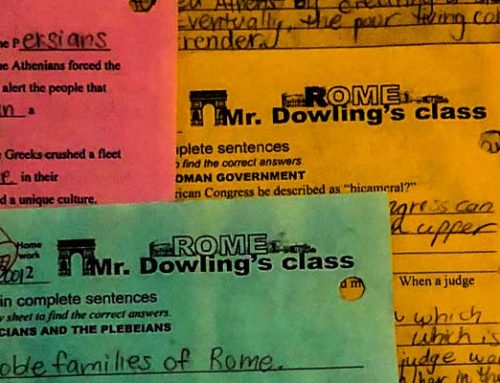Italy is a peninsula that extends into the Mediterranean Sea east of the Greek peninsula. Rome is now the capital of Italy and one of the largest cities in Europe, but it was once the seat of the ancient world’s greatest empire. Outgrowing their home near the coast of the Mediterranean Sea, the Romans expanded across Europe and into Asia and Africa.
In 509BCE, Rome was a small village, but through force or persuasion—Rome took control of almost the entire peninsula by 247BCE. In fact, by the second century of the Common Era, Rome developed into the most significant Western empire of the ancient world. Many of our technological achievements, our ideas about law and government, and the words we use can be traced to the ancient Romans.
Rome grew from a village to an empire partly because the city was protected from enemy attacks. Rome is situated along the banks of the Tiber River, about fifteen miles inland from the sea. The Tiber has a ford, or shallow portion, near Rome. The ford made it impossible for large seagoing ships to attack the city but experienced Roman sailors could navigate the Tiber’s waters in smaller ships.

Roman-Senator
Seven hills surround Rome. The hills made it harder for invaders to reach the city and served as lookout areas for the ancient Romans. Rome is also close to excellent farmland and abundant wood and stone, so the Romans had the resources to supply a large army.
Archaeological evidence suggests that the banks of the Tiber River were first inhabited about 1500BCE, but the origins of Rome are steeped in myth and legend. Many ancient Romans believed twin boys named Romulus and Remus were responsible for the city’s foundation. The legends say an ancient king feared the twins would rob him of his throne, so the king tossed the infant boys into the frigid Tiber River. Soon after, a wolf rescued Romulus and Remus and nursed the brothers back to health.

Romulus_Remus_wolf
Years later, Romulus and Remus decided to establish a city on the Tiber River, but the brothers could not agree on a location. Signs from the heavens told each brother to establish separate cities, and on April 21, 753BCE, Romulus completed the wall around his city. Remus belittled the wall and its builders. When Remus climbed over the wall, the enraged Romulus killed his brother with an ax. Rome is named for Romulus, its legendary founder.
As Rome grew from a small village to a world power between 509BCE and 247BCE, the city was constantly at war with one or more neighbors. At that time, when cities went to war, the victorious army would destroy the conquered city and either kill or sell the citizens of the conquered city into slavery. The Roman model of conquest was different. Rome expanded its territory in part because it extended many of the citizenship rights to the people it conquered.
The Romans did not collect tribute from the conquered people, but they required their neighbors to provide soldiers for the Roman army. As a result, the Romans had a massive source of manpower to draw upon for their many wars.
The Roman army built roads, which helped the cities Rome conquered to become more prosperous through increased trade. Soldiers who served in the army brought Roman customs to their home villages once their service ended. In addition to customs, the Latin language around Rome spread throughout the Italian peninsula.
The immensity of the Roman military allowed them to continue fighting despite tremendous losses. In 279BCE, King Pyrrhus of Epirus defeated the Roman army in two battles. Rome had a larger supply of soldiers, and while the Romans suffered more significant casualties, the losses inflicted by the Romans destroyed Pyrrhus’ smaller army. Today we refer to a pyrrhic victory as an achievement with such disastrous results that it is actually a defeat. If your favorite team wins a game that clinches a berth in the playoffs – but loses two star players to injury in that game – the win could turn out to be a Pyrrhic victory.
By 265BCE, Rome had managed to unite most of what is today the Republic of Italy. The Romans would next turn their attention to a rival in North Africa and create a world empire.
Resources
Download this lesson as Microsoft Word file or as an Adobe Acrobat file.
View a Powerpoint presentation of this lesson.
Listen as Mr. Dowling reads this lesson.
Lexile Measure 1140L
Mean Sentence Length 18.20
Mean Log Word Frequency 3.46
Word Count 728
Mr. Donn has an excellent website that includes a section on Ancient Rome.
A Roman Tale
Romans soldiers often told tales of ferocious soldiers from an earlier age. One popular story was the legend of Mucius. According to the tale, Rome was fighting an Etruscan king whose army surrounded Rome. To save the city, Mucius volunteered to sneak into enemy headquarters to kill the king. The Etruscans captured Mucius and brought him to their king. The king had a blazing urn and was prepared to torture Mucius to death. Mucius was not afraid. He declared, “I am a Roman citizen. My name is Gaius Mucius. I came here as an enemy to kill my enemy, and I am as ready to die as I am to kill. We Romans act bravely and, when misfortune strikes, we suffer bravely. Watch me and learn how insignificant the body is to those who dedicated themselves to a greater cause.”

Mucius then thrust his right hand into the flame. As the flames destroyed his flesh, Mucius told the king that there were 300 equally determined soldiers willing to accept any punishment to defend their city. The frightened king released Mucius and ended the war. We do not know if the stories are real or imagined, but they give us insight into how the Roman army thought.




